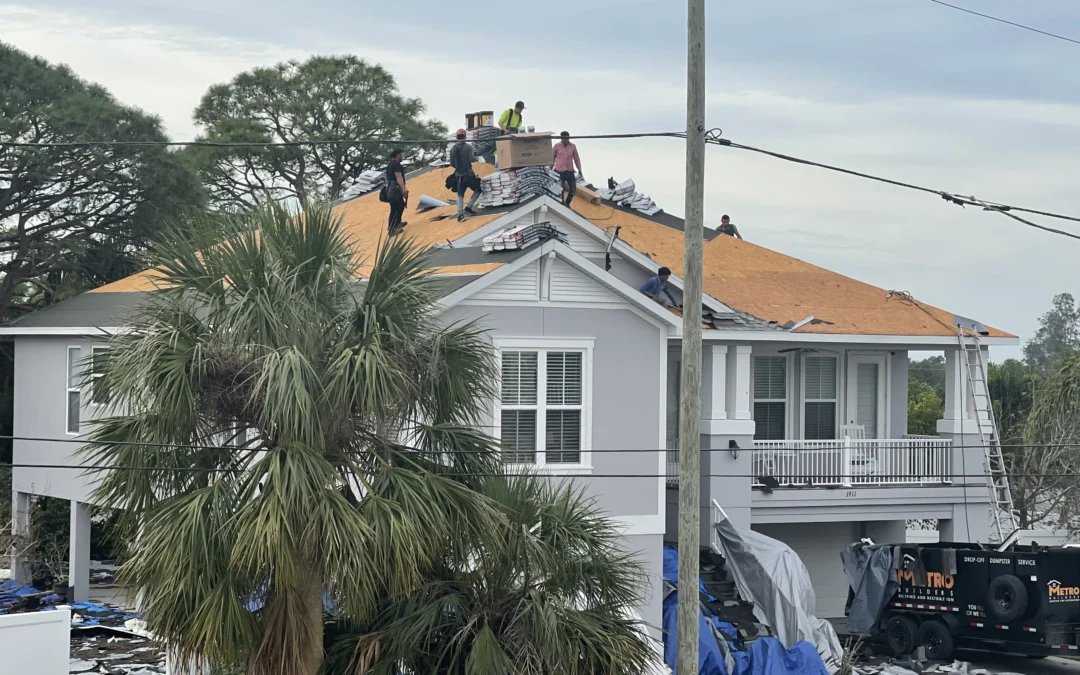Wind rips shingles. Rain follows fast. Your best move is safe, quick protection.
This blog explains how tarps protect your home, what you can do and how pros secure the roof until permanent repairs happen. If you need emergency roof tarping, you will learn what to expect, how to document for insurance and how to move from temporary cover to a full fix.
First Line of Defense: Why Tarps Work
Tarps block wind-driven rain before it reaches open seams, vents and decking. They shed water away from the hole and keep fresh leaks from spreading into insulation and drywall. In Tampa Bay weather, that buffer gives you time to plan permanent repairs.
A tarp is temporary protection, not a cure.
When to Tarp vs. When to Patch
Small, lifted tabs or a single shingle may take a quick patch on a dry, calm day. Missing shingles across a slope, loose ridge caps, or torn flashing near a wall call for wider coverage. Tree limbs or flying debris that expose the underlayment are clear signs of a full tarp.
During heavy weather, a patch can fail under gusts or more rain. A full tarp covers beyond the damage, anchors into solid structure and keeps water out while the storm cycle continues.
Safety First: What Homeowners Should and Should Not Do
Stay on the ground and take clear photos and short videos. Move valuables from the room below the leak and place buckets or bins under drips. Lay plastic over furniture and roll up area rugs to keep water from wicking.
Do not climb on a wet or damaged roof. Slopes get slick fast and fall risk is real. Do not pull on loose limbs or shingles from a ladder. If a room or ceiling is wet, you may shut off circuits to that area only if you can reach a dry panel safely.
Safety is always the priority
Professional Tarping: Step by Step
We start with a ground and attic check. Then we measure the damaged area and the path of water so the tarp covers well beyond the break. We choose anchor points at rafters or decking that is still sound and avoid making nail holes in healthy shingles.
Edges are sealed with compatible tapes or butyl at key seams to steer water off the roof. We route water to gutters or away from them depending on the pitch and the break. Gutters and landscaping are protected with pads and boards so anchors and traffic do not cause new problems. After emergency roof tarping is secured across the opening, our team schedules emergency roof repairs as materials arrive.
Materials That Matter
Heavy duty tarps resist UV and hold up better in Florida sun than thin covers. Cap nails or screws with plastic washers spread the load so the fabric does not tear at the fastener. In some layouts, sandbags or weighted battens add tension without extra fasteners in good shingles.
Butyl sealant and compatible tapes close edges around vents and ridges. Correct placement and tension stop flapping, which prevents wear at the anchor line during high winds.
Insurance Documentation Without the Headache
Start a simple folder with date and time notes, photos and short videos. A quick sketch of the roof slope with the damaged area marked helps the adjuster understand the layout. We add a written scope showing what the tarp covers and what permanent repairs are expected.
A clear file speeds approvals in Hillsborough, Pinellas, Pasco and Manatee. We share moisture readings and interior photos so the claim shows both exterior and interior protection in one place.
What Comes After the Tarp
We dry the interior where water entered and set protection inside if ceilings or walls are damp. Temporary ceiling plastic, floor covers and dehumidifiers keep rooms usable while schedules are finalized. We confirm structural needs, order materials and set inspection steps based on city or county rules.
Next comes the permanent work. We line up urgent roof repairs such as replacing damaged decking, installing new underlayment and resetting flashing and shingles or metal panels. If a permit is required, we pull it and meet inspectors, so the job stays compliant.
Real Tampa Bay Case Snapshot
A Clearwater bungalow lost ridge caps during a fast squall. Rain pushed through the opening and stained the bedroom ceiling. We arrived the same day, secured a high-coverage tarp that extended past the ridge and set up dehumidifiers inside.
The adjuster met us two days later. Our photos, sketches and scope supported the claim and the rebuild plan. Within the next weather window, we replaced the damaged decking, installed new underlayment and ridge and removed the tarp. The bedroom stayed dry the entire time because the tarp was held through two more showers.
Homeowner Checklist
- Take photos and short videos from the ground and inside the house.
- Move valuables, electronics and rugs away from the leak path.
- Catch drips in clean bins and place plastic over furniture.
- Do not climb on the roof or lean ladders against loose gutters.
- Shut off circuits to wet rooms only if you can reach a dry panel.
- Note the time of the storm and when you first saw water.
- Call your insurance company and start a simple claim log.
- Save receipts for temporary protection or overnight lodging if needed.
- Ask for a written scope of tarping and the plan for permanent repairs.
- Confirm that the contractor is licensed and insured and pulls permits when required.
- Request daily check-ins until permanent work begins.
Red Flags to Avoid
Storm stress can attract fast talkers. A few signs tell you to slow down and verify credentials.
- Cash-only demands are a warning sign and should be declined.
- Pressure to sign on the spot without a written scope is risky.
- Vague descriptions of work provide little protection if the weather turns.
- No local address or license information means you should keep looking.
- No plan for permits when one is required is not acceptable.
Final Takeaway
Tarping buys time, protects your home and keeps repairs smaller and simpler. With a safe plan, good materials and clean documentation, you can move from cover to completion with confidence.
We are local, licensed, insured and we pull permits when required. We respond across Hillsborough, Pinellas, Pasco and Manatee with fast tarping, clear documentation and a plan for lasting repairs. Call now or fill out the form for your free evaluation today.
FAQs
Will a tarp affect my insurance claim?
Adjusters expect reasonable steps to prevent further damage and documented tarping usually supports the claim rather than hurting it.
What if it keeps raining for days?
We check anchors, tighten edges and adjust water paths as needed. Interior drying continues, so rooms stay stable until the roof is rebuilt.

Chris Price is the CEO of Metro Builders, with over 25 years of experience in construction and project leadership. He’s passionate about building strong teams, delivering quality projects, and driving innovation in the industry.





Recent Comments